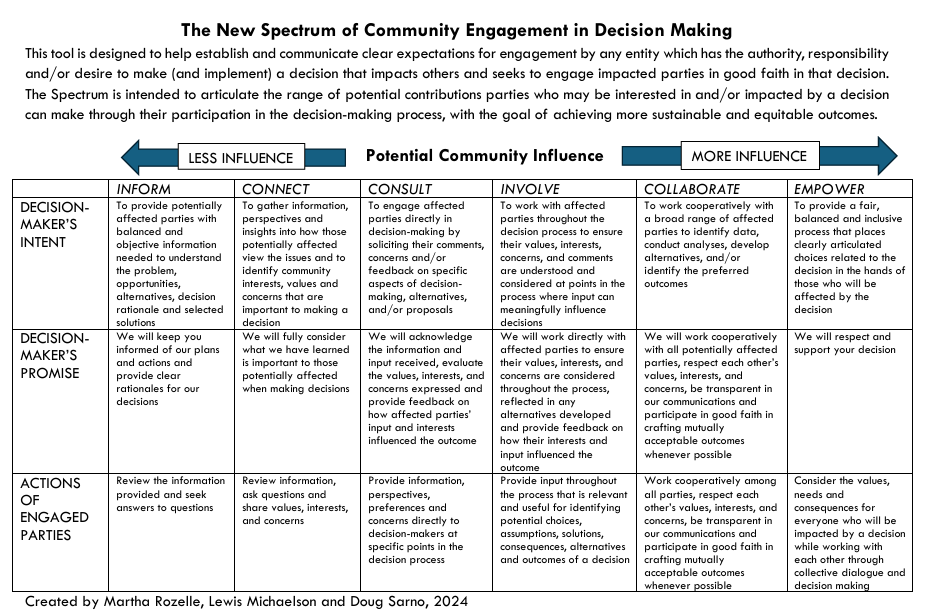
When public engagement became real.
The Genesis of the Spectrum of Public Participation and its potential evolution
The Genesis of the Spectrum of Public Participation and its potential evolution
The Spectrum was created by Marty Rozelle, Doug Sarno and Lewis Michaelson in 1998. As public participation practitioners they were responding to the need to better define:
- what constitutes participation in public decision-making,
- the purpose of that participation, and
- the degree of influence the public could have on the decision.
They focused on the obligations of decision-makers in engaging with the public based on what they called the “promise to the public”. The driver was to increase transparency and accountability. The product originally created by this insightful team was adopted by the International Association for Public Participation in 1999. It is now widely used and cited in academic publications and has become the foundation of many policy and strategy documents.
What was happening in the practice then and what has happened since
Public participation in the USA in 1990s was largely led by government entities who engaged in limited and sometimes inauthentic processes for sharing power and influence on their decisions. A lot has changed since then, and models like the Spectrum undoubtedly helped shape that journey.
As the 21st century dawned, many decision-makers began experimenting with more robust processes that promised greater degrees of influence on a decision for those participating. The focus of the decision expanded beyond one-off, project-based decisions to more long-term planning, programmatic and policy decisions, as decision-makers and practitioners began to appreciate the opportunities for trust, relationship and community building achieved through more thoughtful and empathetic forms of participation. Earlier phases of community research, education and involvement prior to explicit decision-making were also introduced.
Another development, since the 1990s has been increased emphasis on participation in non-governmental decision-making by for-profit, non-profit, and community-based organizations. Community-led processes and the need to recognize and promote these have become a particular focus of the field.

The implications of changes to the practice for the Spectrum
Some have questioned whether the IAP2 Spectrum of Public Participation is, or should be, more inclusive by explicitly acknowledging decision-making not initiated or convened by formal governmental authorities.
In January 2024 practitioners were offered the opportunity to participate in a dialogue with the creators of the Spectrum. This was an off shoot of the project that created the interviews with early practitioners featured on this site. These online sessions that included dialogue with participants provided opportunity for people to learn about the origin of the spectrum while also asking “in what ways is the Spectrum still relevant or not.” The three online dialogues that were offered in different time zones attracted 200 participants from seven countries. Participants in these sessions noted the key features of the Spectrum e.g., support for its horizontal and non-judgmental orientation was virtually unanimous. However, there were also comments about when and how it was less useful. Many agreed that it is often misunderstood or misused.
A New Spectrum of Community Engagement for Decision Making
The experience of those webinars’ dialogues in early 2024 led the spectrum creators into a deep dive as they asked the question, if we were doing the same task today to create a Spectrum, what would it look like? They set out to accomplish four things:
- Maintain key aspects of the original Spectrum that from experience and feedback are considered essential elements for a spectrum’s use as a tool (e.g., simplicity and its non-hierarchical format)
- Reflect on the advancements in techniques and tools over the last three decades
- Reflect the expanded uses and users of participation processes in the past three decades
- Eliminate the implied focus on government entities as the primary or sole sponsors of decision-making processes
The discussion between Doug, Marty and Lewis confirmed two challenges likely to be present in any future iterations of a changed spectrum.
- finding the perfect words that mean what we intend and still works across different cultures and different languages. Meanings can be “lost in translation” both figuratively and literally.
- keeping the Spectrum simple to use as a practical tool, especially when trying to discuss and determine a decision-maker’s purpose and sincere intent when engaging other parties.
The authors of the original spectrum are presenting this new version based on six months of discussions and revised drafts prompted by what they heard from their interactions with practitioners. They are inviting practitioners who currently use the spectrum to offer thoughts on whether and how well their new spectrum responds to contemporary challenges to effective and ethical decision-making as it relates to ANY entity that engages others in their decision-making processes.

New column titled “Connect”
The timing, methods and purposes for engaging communities (of whatever kind or classification) can often be tied to gaining a better understanding of their needs, values and preferences. Whether or not focused on a specific decision, these forms of engagement have the power to inform and improve future decision-making. It was decided to call this level “CONNECT.” Similar to “Inform”, Connect is not explicitly tied to the traditional concept of power sharing, but can be an influential and beneficial prelude to subsequent decision-making. This new level fills a potential gap between Inform and Consult that better reflects the more varied and robust opportunities for engaging communities within the broader context of current or future decision-making.
New row titled “Actions of Engaged Parties”
Adding this row may seem paradoxical given there was originally a third row that provided example techniques that was removed in 2014. The authors saw an opportunity to give balance to the Spectrum by describing from the perspective of affected parties what was being asked of them (subject to their own desire and willingness to engage). Consider this the companion to the decision-maker’s promise. The elements of this row represent voluntary actions and expectations of parties being engaged at each level of the Spectrum.
New language
- the word “public” has disappeared, due largely to its vague and non-inclusive nature.
- The title refers to community engagement, reflecting that community members can both participate in and initiate decision-making processes.
- The phrase “those affected or potentially affected” has been used liberally to reflect the scope and breadth of entities that should be at the table for decision-making, which the words “public” or “participants” or “stakeholder” do not always capture.
- the word “party” or “parties” has been introduced, terms borrowed from the language of negotiation. This is to reflect that interested or affected entities can be any combination of: individuals, communities of interest or locales, organized groups, government agencies, elected officials, sovereign nations, corporations and other business entities, and anyone else not mentioned. There may be another word that serves that neutral and inclusive purpose better!